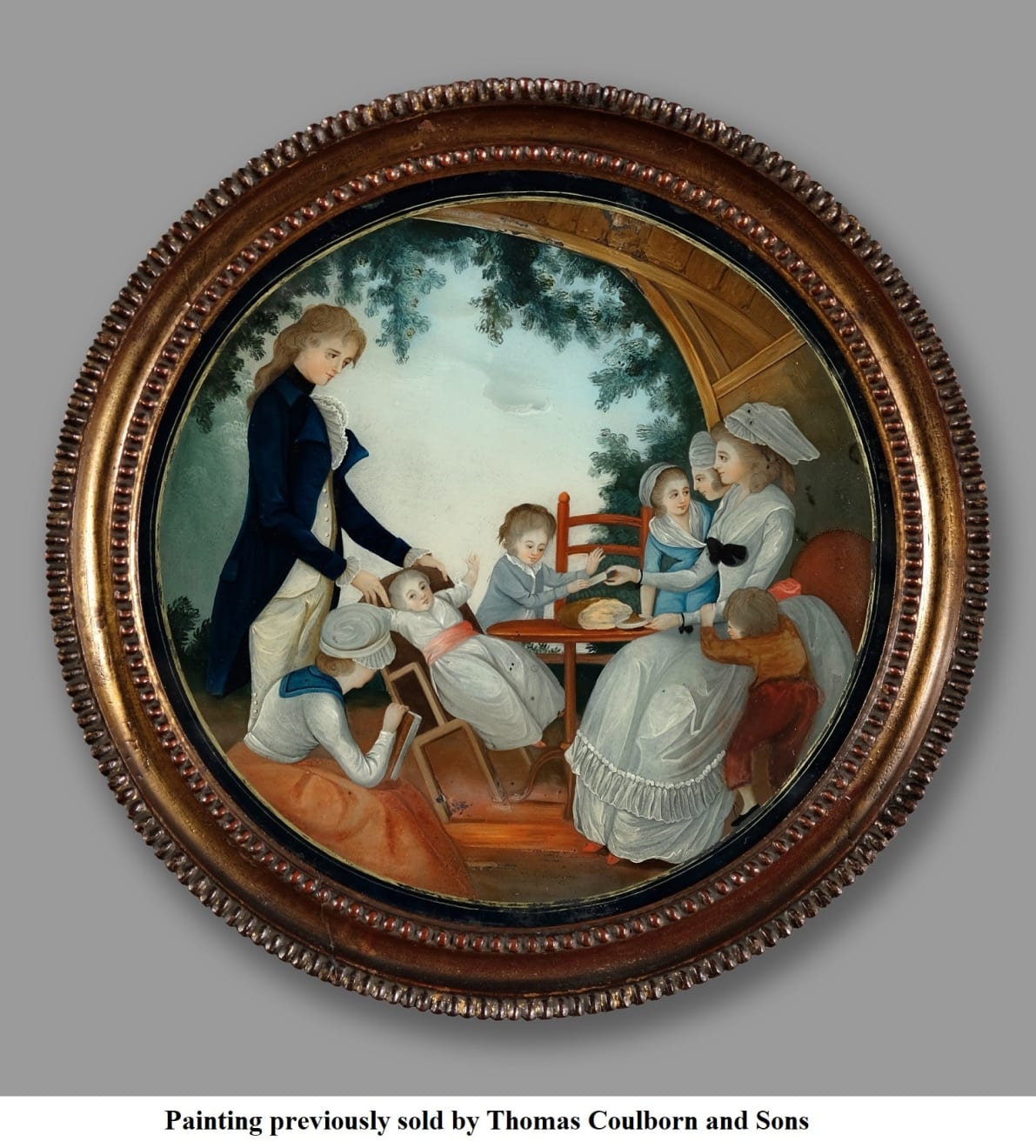Open a larger version of the following image in a popup:
 'The First Interview of Werther and Charlotte', stipple and etching with hand-coloring by John Raphael Smith (1751–1812) after Henry William Bunbury (1750–1811), October 16, 1782 , 35 × 40.9 cm, Gertrude and Thomas Jefferson Mumford Collection, Gift of Dorothy Quick Mayer, 1942, The MET Collection, Accession Number: 42.119.66
'The First Interview of Werther and Charlotte', stipple and etching with hand-coloring by John Raphael Smith (1751–1812) after Henry William Bunbury (1750–1811), October 16, 1782 , 35 × 40.9 cm, Gertrude and Thomas Jefferson Mumford Collection, Gift of Dorothy Quick Mayer, 1942, The MET Collection, Accession Number: 42.119.66
 'The First Interview of Werther and Charlotte', stipple and etching with hand-coloring by John Raphael Smith (1751–1812) after Henry William Bunbury (1750–1811), October 16, 1782 , 35 × 40.9 cm, Gertrude and Thomas Jefferson Mumford Collection, Gift of Dorothy Quick Mayer, 1942, The MET Collection, Accession Number: 42.119.66
'The First Interview of Werther and Charlotte', stipple and etching with hand-coloring by John Raphael Smith (1751–1812) after Henry William Bunbury (1750–1811), October 16, 1782 , 35 × 40.9 cm, Gertrude and Thomas Jefferson Mumford Collection, Gift of Dorothy Quick Mayer, 1942, The MET Collection, Accession Number: 42.119.66
Chinese Export Glass Painting
CHINA, CIRCA 1785
31.5 x 31.5 cm
12 ½ x 12 ½ in
12 ½ x 12 ½ in
7043
Further images
After Henry William Bunbury’s The First Interview of Werther & Charlotte, one of a series of prints depicting the life of Werther and Charlotte from Goethe's The Sorrows of Young...
After Henry William Bunbury’s The First Interview of Werther & Charlotte, one of a series of prints depicting the life of Werther and Charlotte from Goethe's The Sorrows of Young Werther, 1774. The hero encounters Charlotte caring for younger siblings after they have lost their mother. In an arbour, Charlotte, sitting at a small round table, hands slices of bread to four children, one of whom hangs from her left arm, while another sits back looking up at Werther, who stands behind her, tilting her chair, and looking across at Charlotte and a maid sits in the right foreground holding a pitcher on her knee. In its original Chinese carved and decorated frame.
By the 1780s, it was fashionable for Chinese painters to copy English and European engravings for export. This example is after Henry William Bunbury’s The First Interview of Werther & Charlotte, one of a series of prints depicting the life of Werther and Charlotte from Goethe's influential novel of the time. An engraving after Bunbury can be found in the MET Collection (42.119.66). Interestingly, Smith cut down the plate for a second state of this print, having the image inset within a circle measuring 311mm in diameter, which was most likely the influence for this painting. A full set of the scenes was in the McAlpine collection at Fawley House.
J.W, von Goethe (1749-1832), ‘The Sorrows of Young Werther’: is the story of a romantic, artistic young man who finds it difficult to reconcile his sensitivity and ideals with the real world. He goes to the country to improve his wellbeing where he falls in love with Charlotte (Lotte), who is already engaged to his friend Albert. Werther becomes increasingly obsessed with her and due to unrequited love and his sense of despair in life, Werther takes Albert's pistols and kills himself. The book was highly influential in European culture. Scenes from the narrative were realised in engravings and appeared on objects such as porcelain (examples can be found at the Victoria & Albert Museum). It became fashionable for men to copy Werther’s clothing described in the story, which also inspired a spate of copycat suicides.
Generally, the glass used for such pieces was imported from England, despite China’s long history of glassmaking. Contemporary reports note that the Chinese made glass for decorative objects but attempts at making flat glass were frequently ‘thin and brittle’ in contrast to the ‘thick and crystal-like’ glass produced in the West.
By the 1780s, it was fashionable for Chinese painters to copy English and European engravings for export. This example is after Henry William Bunbury’s The First Interview of Werther & Charlotte, one of a series of prints depicting the life of Werther and Charlotte from Goethe's influential novel of the time. An engraving after Bunbury can be found in the MET Collection (42.119.66). Interestingly, Smith cut down the plate for a second state of this print, having the image inset within a circle measuring 311mm in diameter, which was most likely the influence for this painting. A full set of the scenes was in the McAlpine collection at Fawley House.
J.W, von Goethe (1749-1832), ‘The Sorrows of Young Werther’: is the story of a romantic, artistic young man who finds it difficult to reconcile his sensitivity and ideals with the real world. He goes to the country to improve his wellbeing where he falls in love with Charlotte (Lotte), who is already engaged to his friend Albert. Werther becomes increasingly obsessed with her and due to unrequited love and his sense of despair in life, Werther takes Albert's pistols and kills himself. The book was highly influential in European culture. Scenes from the narrative were realised in engravings and appeared on objects such as porcelain (examples can be found at the Victoria & Albert Museum). It became fashionable for men to copy Werther’s clothing described in the story, which also inspired a spate of copycat suicides.
Generally, the glass used for such pieces was imported from England, despite China’s long history of glassmaking. Contemporary reports note that the Chinese made glass for decorative objects but attempts at making flat glass were frequently ‘thin and brittle’ in contrast to the ‘thick and crystal-like’ glass produced in the West.





